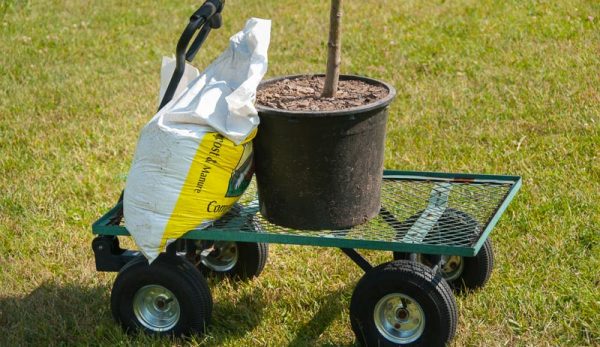
Judging from the gusts of wind and snowflakes blowing past my window, no one would guess spring arrived more than two weeks ago. It’s hard to picture planting a garden when there’s still an unbroken blanket of snow across the fields.
But as the sun rises higher in the sky and temperatures warm, these wintry conditions ultimately wage a losing battle. Spring is coming slowly but surely, which means it’s time for me to purchase a new gardening cart.
Garden Cart?
Wait, what? If that came out of left field, let me explain.
I’m busily stocking up on spring garden supplies. And I’ve come to the conclusion I need to replace my existing gardening cart. It’s been in service since 2005, and it’s definitely showing its age.
It’s a four-wheeled, metal flatbed cart pulled by hand or by tractor. Unfortunately, the steering mechanism allowing the handle/tongue to turn the front wheels broke several years back. My attempts to repair the break have, sadly, seen only modest success.
Having acknowledged the need for a new gardening cart, I’m faced with a new question: what type? Gardening carts come in many different designs, because—as far as I’ve gathered—“gardening cart” is a rather vague term.
All sorts of carts can be used in the garden, ranging from wheelbarrow types with a pair of front wheels to the four-wheeled carts I prefer. There are even utility carts that stack multiple flat beds vertically like a multi-story house, allowing you to pack more transportation potential into a smaller footprint.
Read more: Wheelbarrows are perfect for gardening—here’s why.
4 Wheels for Me
A utility cart might be perfect for shifting potting supplies and seedlings across smooth terrain, and a wheelbarrow can be useful for negotiating tight quarters. But I’m more interested in the adaptability of a four-wheeled cart.
I want a gardening cart that I can pull by hand around the garden and between beds. But I also want one I can hook to a garden tractor for towing heavy materials around the farm. For example, when moving small loads of compost.
Read more: Consider these 4 types of tractors for your small farm.
Material Matters
This brings us to another consideration: From what material should a gardening cart be constructed? I’ve used both polypropylene and metal carts, and they offer different strengths and weaknesses.
- Metal carts are literally stronger and can carry more weight, but they can also rust.
- Polypropylene carts might not be as strong. But if you avoid overloading them, they can hold up for years with little wear or tear.
Typically, polypropylene carts are designed with solid beds and raised sides. This design makes them suitable for transporting loose materials (like compost) without spilling. They can even hold water, which is either an upside (say, if you want to catch rainwater) or a downside (if that cartload of gardening tools you forgot about fills with rainwater).
In contrast, metal gardening carts (either with or without sides) are often constructed from a crisscrossing mesh of metal strips. This creates a strong but open design that allows rain to fall through.
This is great for projects like drying onions. But unless you cover the flatbed with something nonporous (like wood or thick cardboard), moving compost and similar materials doesn’t work so well.
Right Cart for the Job
As you can see, there are a lot of factors to consider when shopping for a gardening cart. My 2005 model is a metal cart with a flat mesh bed, but I may opt for a polypropylene cart this time around.
Transporting compost down narrow paths between raised garden beds will be its primary purpose, so having a solid bed with sides will be a positive. And I may opt for solid rubber tires instead of pneumatic tires, since the solid tires should last longer and require less maintenance while still serving suitably.
Besides … steering or no steering, I reckon my old mesh garden cart still has a few more years of drying onions left in it!




